mytest






![]() UPDATES ON TWITTER: arudoudebito
UPDATES ON TWITTER: arudoudebito
Hi Blog. As nothing more meant to this than an interesting historical diversion on a rainy Sunday, here are some screen captures sent to me by friend Martin, who recently asked me to look over a screenplay for a movie about WWII Japanese pilots and the Pacific War. Interesting stuff.
Japanese WWII propaganda, from children’s textbooks explaining the purpose of the Greater East Asia Co-Prosperity Sphere (DaiTouA), and from psychological warfare leaflets to undermine the morale and sanity of the enemy.
Courtesy of http://www.2bangkok.com/wwiipropaganda.shtml
The old Japanese writing style at times makes for slow reading. And does anyone know — were contemporary Japanese school children first instructed in reading in katakana before hiragana? Or is the script designed for non-native eyes? Arudou Debito in Sapporo
Here is a line up of all the children who ware brought under the Japanese Imperial umbrella. What I find interesting is that the writing is from left to right, even though in contemporary Japanese publications I’ve seen if the writing was not vertical, it was rendered right to left.
(click on any image to expand in your browser)
Here we have the Western powers exploiting the East Asian lands for their own ends. Love the caricatures of the machinating Brits and Yanks.
Now here we have them at a loss as the Japanese Empire liberates the lands and receives the cheers of the inhabitants. Asia has finally “kicked out” the white race. (Note how present-day Indonesia and Malaysia don’t get independent flags of their own.)
Here are the benefits accrued to the Asian peoples at last. An independent Burma and Philippines. An expanded Thailand. An India finally rid of the British, a Nationalist China (rendered as “Chuukuo”,) allied with Japan, a prosperous Manshukoku (not Manchukuo). And happy Malays and Javanese (who seem to get happiness out of this, but unlike the others not their own country).
This somehow doesn’t feel like it’s from the same book, because the level seems truly grade-school. We have the regular rhetoric deferential to authority (even the horse is granted an honorific), and how the “Butaichou” (squad leader) is so nice.
More of the images of walking in lockstep, with everyone with one heart. Of course, by the logic of reading from right to left, it’s clear who’s in charge. And note how the crowds are still separated between Japanese and colonized. One heart, two systems. Seems the natural order.
Next comes the educational opportunities. Learn Japanese, come to Japan, become fluent in the language and you will do well. Is that possibly Tokyo Imperial University (today’s Toudai) in the background of the (white) Japanese and (colored) Indonesian (?) students?
Here we have the slogan of “Co-existence, Co-prosperity” (kyouzon kyouei) and the benefits therein of being freed (namely happiness). A multilingual Asia linked together, from Indonesia and Oceania to South-East Asia to beyond the Gobi Desert. Interesting how Australia, India, and Siberia (which looks submerged) mark the natural boundaries of DaiTouA.
Now it gets interesting, as the rhetoric (from a different publication) leaves the comfort zone of Japanese linguistics and tries to demoralize English readers. Themes of being surrounded, impending death, and mockery of weakness are regular tactics of psychological warfare. But the interesting logic regarding being too busy to bother with dead people is an interesting twist and tack. If you were in the jungle, particularly in the Philippines for years on end, waiting for MacArthur’s uncertain return, would this affect you?
Last image for this blog entry. This may seem a bit silly until you realize that this leaflet may be all these people have to read in the jungle. When you’re starving for reading material to stave off the combat mixture of terror and boredom of waiting for sudden attack, this may well get to you. You have lots of time to monitor and overthink your bodily functions.
I wonder where the English came from, too. I can scarcely imagine many Japanese educated under the current Monkashou system who can write at this level.
ENDS
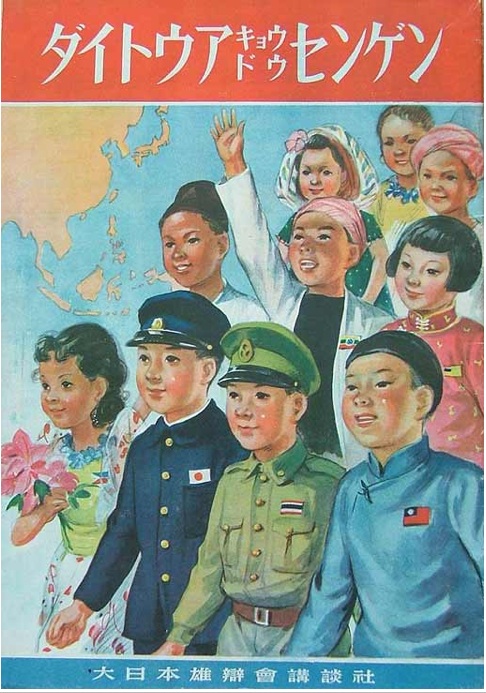
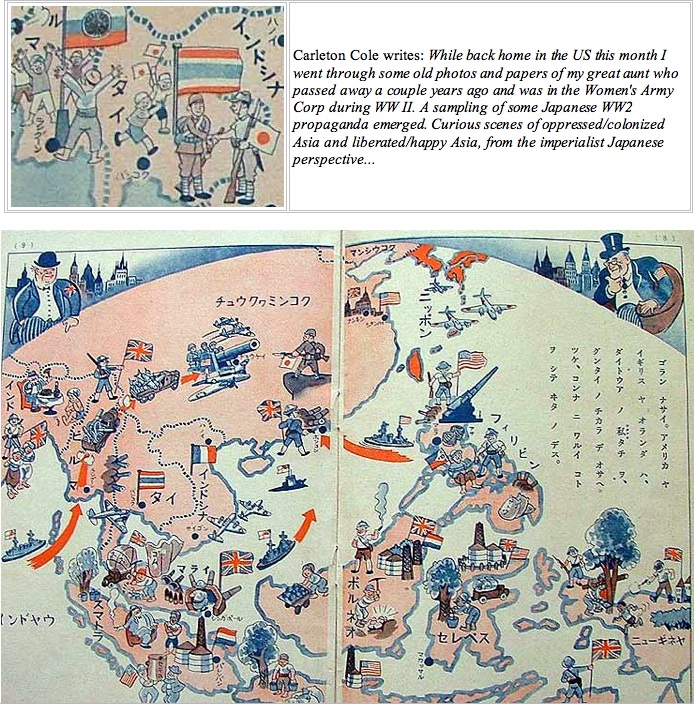
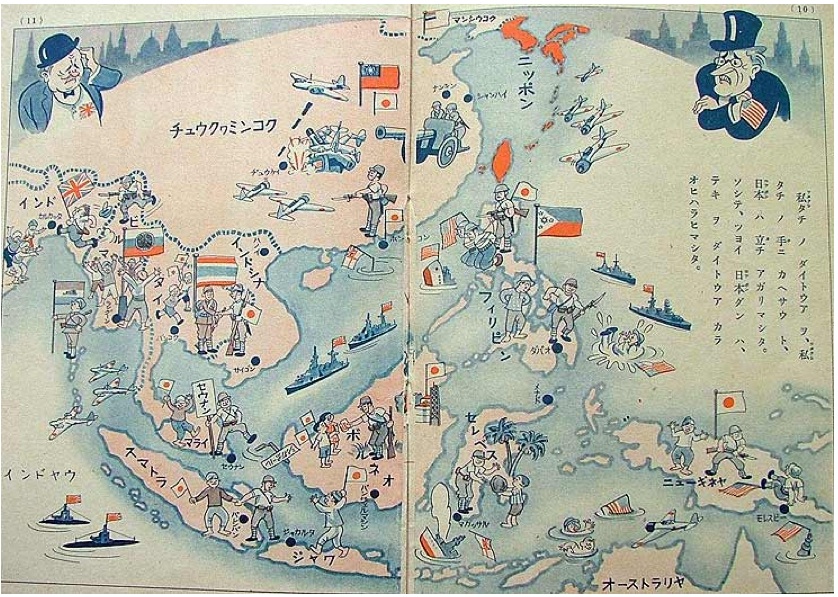
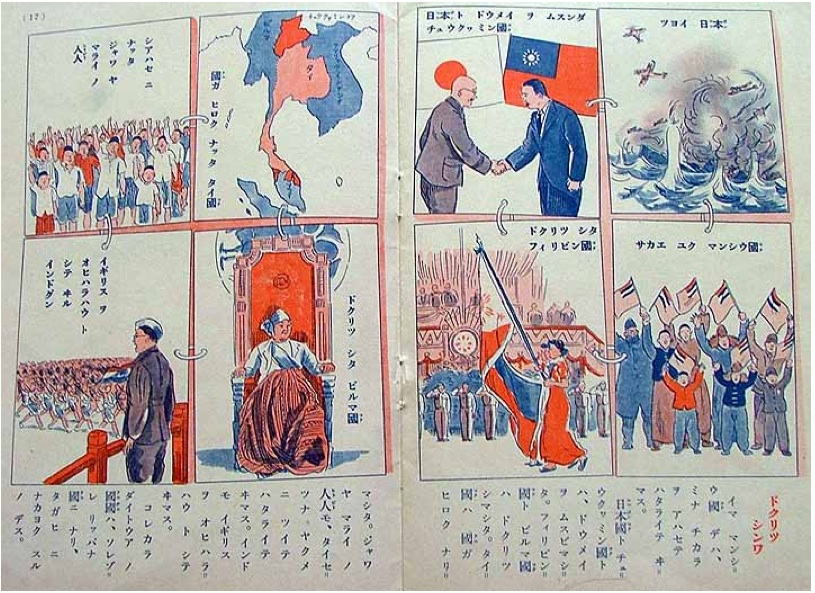
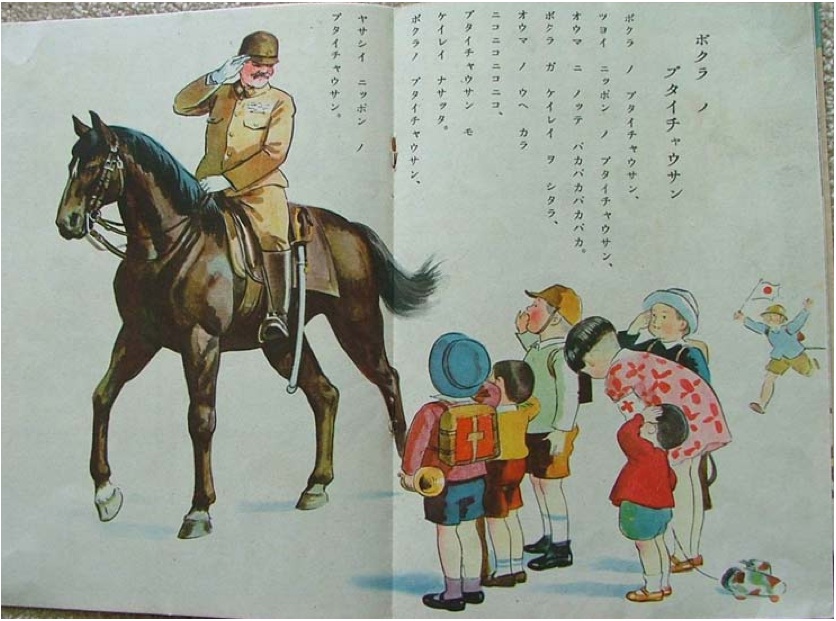
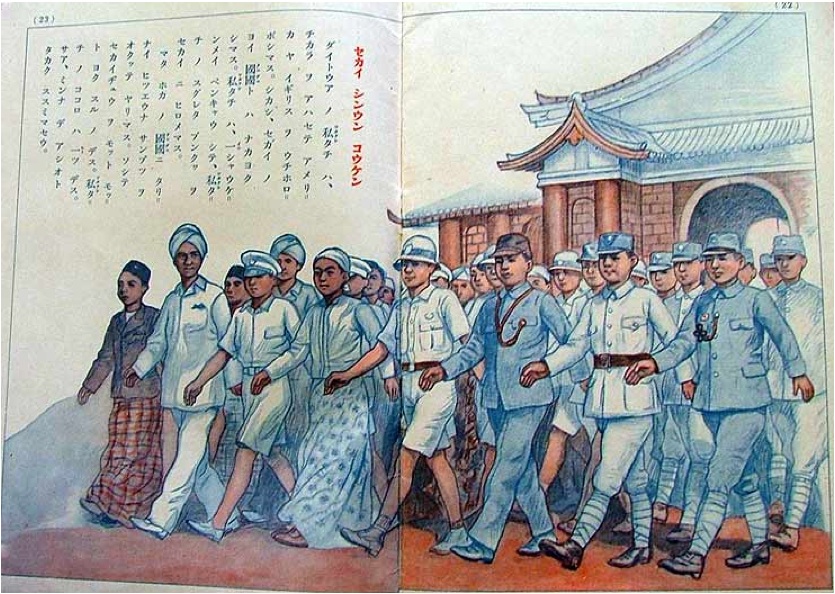
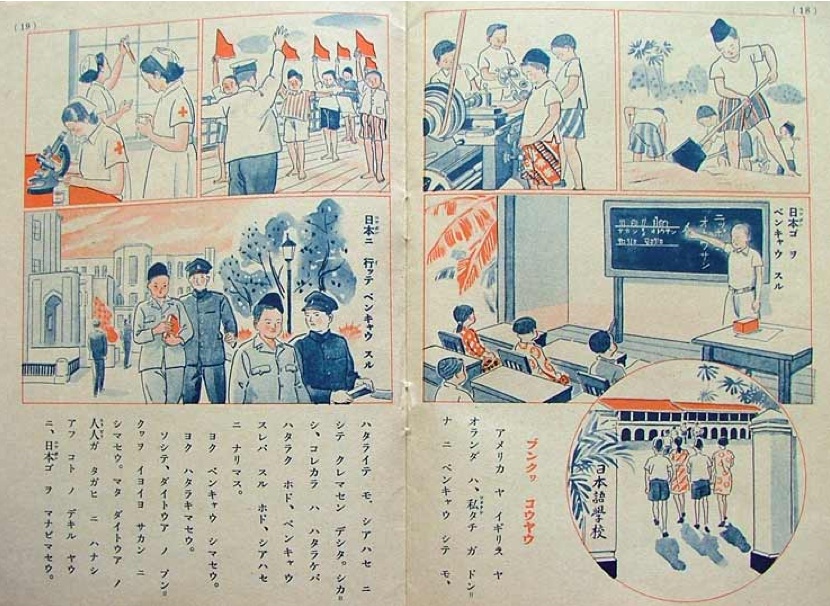
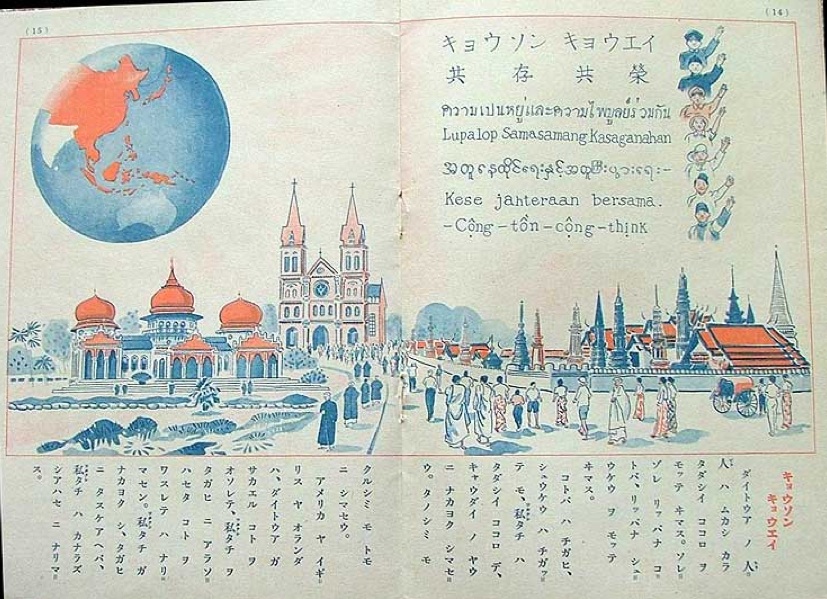
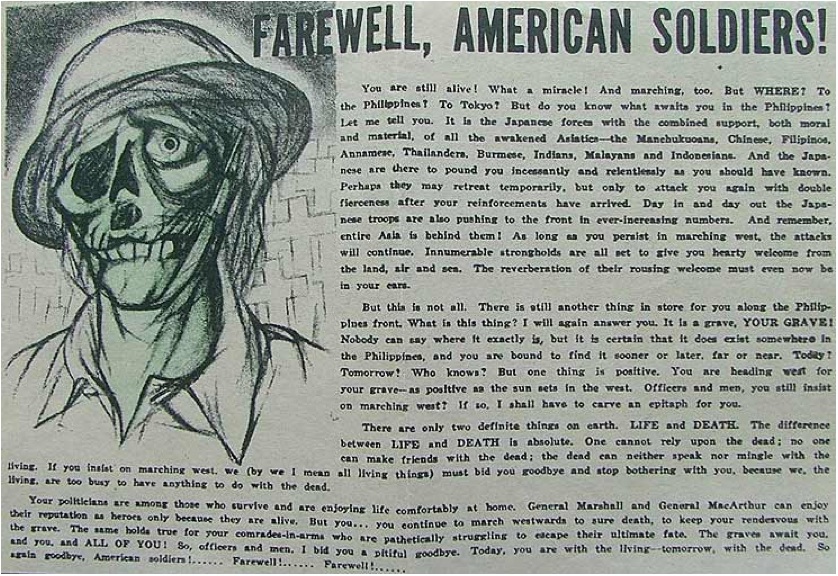
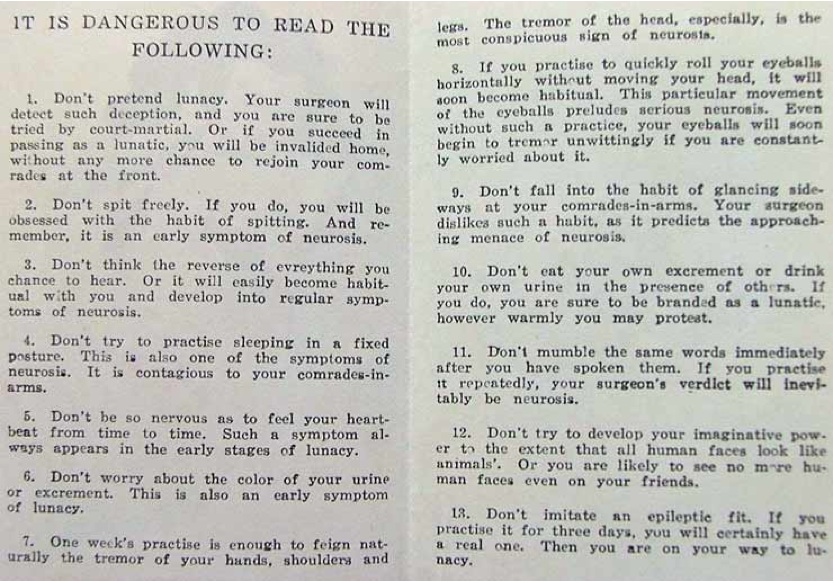
14 comments on “Sunday Tangent: Fascinating DaiTouA WWII propaganda”
Well, clearly these were the only textbooks Tamogami Toshio’s village had available during the Occupation.
I wonder what excuse the village school board used for where the legitimate government’s shipment went . . .
Interesting stuff. Back when I worked in Japan, I visited The Former Kaichi School in Matsumoto, and they had some WWII textbooks displayed under glass. From their covers, I could guess as to what the contents contained, and there may have been a note under the display explaining how war propaganda was included in children’s books at that time, as well. This post gives a better idea of what was inside those books, however, than covers can.
Thanks for posting!
That’s a fascinating document. Thanks!
I wonder, looking at the map above, on the island of Borneo, there is an oil field with the japanese flag over it, and next to it on the island of Celebes, a child handing some coconut to the imperial soldier, ain’t all this just reflecting the true spirit of the colonization of asia by the superior and enlighted imperial forces who were there to free their oppresed asian siblings from the tirany of the western powers? In the end this characterization just reflects what was this all about, a struggle to dominate over the natural resources of the entire asian continent which Japan needed desperately as an emerging industrial power of the time, just this. It amuses me when actually from time to time somebody comes out to say that Japan greatly enriched material and culturally those countries during the occupation, and that is just unsensible (to say the less) to those who suffer a cruel and bloody tirany on their own land.
re: “Nationalist China (rendered as “Chuukuo”,) allied with Japan”
It’s actually rendered “Chuukwa Minkoku” which is the standard for Republic of China today (中華民国) with a labialization (kwa instead of ka). I tried to reproduce the katakana, but my computer won’t do it. The labialization with the “k” series is archaic. Emperor Showa used it, but I think it died out with him.
An interesting blog entry. Thanks for posting it.
Fascinating. When I took a step back and thought about all the children that are now politicians who read these books when they were kids, I realize why Japan is in the pickle it’s in today. My grandfather brang back a bunch of Japanese items from WWII (which I am currently trying to return to the families), most of which are letters. It’s interesting to see the difference of what the soldiers thoughts were, and what the governments agenda was. True honne and tatemae, in the sense that the soldiers mind and the Japanese soul were two very different things at that time. Thanks for posting this Debito.
John, Japanese computers can still handle the small ゎ in “kwa”; the problem is that you can’t get it by actually typing “kwa”. You have to type “xwa” to get a small “wa”. “Kwansei” University still uses it, but try saying it like that and people under about 70 will look at you funny.
This syllable is still going strong in Okinawan, where the word シークヮサーor シークヮーシャー has found its way into Japanese. トゥヮ、ヌヮ、ドゥヮ (twa, nwa,and dwa) exist in other Okinawan dialects.
And Debito, those two buildings do look like Tokyu University’s main library (right, back) and Yasuda Hall (left, foreground). They’re out of position, but they look right — and they’re encouraging the colonized to go there! A surprising bit of openness for the era.
“Or is the script designed for non-native eyes?”
Katakana was used as the phonetic Japanese script of the day for official documents. The records of the Imperial Diet, for example, are in katakana. As you can no doubt tell, there are many kanji that either fell out of use or were simplified after the war. The switch was quite controversial in literary circles, apparently.
— That wasn’t the question. The question was, was katakana the first script learned by Japanese children of the day? Or is it the script for L2 in specific? (The writing order, left to right horizontally, is different, for example.) I am quite aware of prewar kanji and kana predilections.
Great post, Debito-san. I’ve always had a strange fascination with propaganda posters and leaflets. They’re such an interesting snapshot of the psychological warfare that goes on during any given campaign.
Some years ago I was writing a paper about brainwashing in Japanese-occupied Manchuria (“Manzhouguo” in my neck of the woods) and I tracked down some Manchukuo propaganda posters. They were quite interesting, as well. This Yahoo China page has some good examples:
http://newspic.cn.yahoo.com/social/article/gallery_show/p_102540/#
The 3rd one is especially interesting, with marauding soldiers murdering civilians in China on the left side and everybody living happily and waving little Japanese flags in Manchukuo on the right. The Manzhouguo flags waving from the Great Wall is an interesting detail, too.
Debito, I actually have copies of the textbooks used in Taiwan at that time and have seen the original textbooks in Japan that they were based upon (much of the contents are identical, with some chapters replaced by ones written just for Taiwan) and yes, they start with katakana. In fact, I just glanced through the 12 volume set of elementary textbooks for colonial Taiwan in the 1937-1942 period, and hiragana doesn’t even appear until midway through book 3. As far as I know, it was only post-war that katakana even came to be associated with foreign words.
”The writing order, left to right horizontally, is different, for example.”
The commonly held idea that writing from left to right horizontally (hidari-yokogaki) in Japan was an innovation of the postwar is not terribly accurate. People have done studies of this stuff and found that there were plenty of instances where hidari-yokogaki was used domestically (and not just for the “colonies”) in Japan before the end of the war.
Try 横書き登場―日本語表記の近代, if you are interested.
Anyway, here is a picture of a 1938 advertisement for vitamins in Japan. The poster heading is in migi-yokogaki, while the writing on the label of the product shown in the poster is in reverse. This is a product for Japanese consumption […]
I would imagine that the practice of writing left to right does reflect a cache of sophistication because “that’s the way they do it in Paris and New York”. However, 1938 was not a terribly foreigner-friendly time in Japan’s history. Then again, the label is also in English.
BTW, that was a six-year elementary school course, to that means they started learning hiragana towards the middle of second grade. Later volumes are mostly in hiragana, although textbooks from earlier years had a good mix of katakana and hiragana text, and they actually DO use katakana to indicate foreign proper nouns. However, there are fully katakana readings as late as book 7, i.e. beginning of 4th grade, which is already a much higher reading level than the text in the above scans. These texts are actually quite simple, with virtually no kanji, and would probably be 2nd grade- early 3rd grade for the time.
On a somewhat related note that made my day – I just returned from Tokyo’s Konan Immigration, detention and deportation facility. Someone has a wonderfully ironic sense of humor there – The musak on loop is
http://en.wikipedia.org/wiki/I_Vow_to_Thee,_My_Country
Brilliant! I am fascinated by this type of historical document.
Permission to crosspost links and facebook it?
Thanks Debito-san!